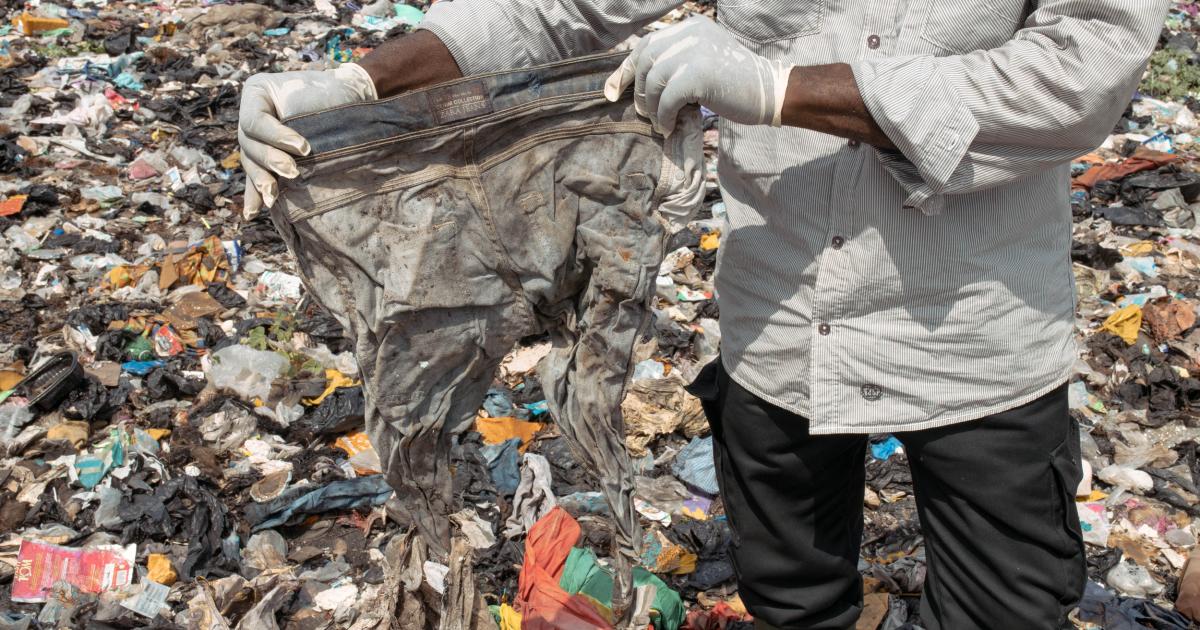Fashion waste from UK brands including Next, Asda and M&S have been found in protected wetlands in Ghana, according to Greenpeace.
The campaign group’s investigative unit Unearthed and its Africa branch gathered stills and footage of discarded clothes at a huge new dumpsite growing in a protected nature site which is home to rare birds and turtle species.
The team found garments discarded by UK consumers from high street brands in areas at or close to two open-air waste dumps that recently appeared inside the Densu Delta – designated as a habitat of “international importance” under the Convention on Wetlands.
Garments
One of the dumps, Glefe, has been established for four years, according to Google Earth historical images, and looms taller than a two-storey building in places. The second, Akkaway is less than a year old but rapidly expanding, Greenpeace said.
Clothes from Zara, H&M and Primark were also found at a third dump on a riverbank outside the nature reserve, from where fashion waste often floats downstream, polluting the wetlands.
The campaigners said they are concerned about the impact of microplastics and chemicals released from the textiles waste on the local wildlife.
Meanwhile, local communities say their fishing nets, waterways and beaches are clogged with synthetic fast fashion exported to Ghana from the UK and Europe, they said.
Ghana is the world’s largest importer of used clothing, with 15 million items of discarded garments arriving each week, according to Greenpeace research.
Dump
Meanwhile, UN trade data shows the UK sent 57,000 tonnes of fashion waste to Ghana last year – more than to any other country except the United Arab Emirates.
This overspill has overwhelmed Ghana’s capital city Accra, resulting in new waste dumps appearing just outside, Greenpeace said.
The Densu Delta provides a habitat for birds such as rare roseate terns, which migrate from the UK, and curlew sandpipers, which visit from the Arctic tundra.
The endangered leatherback and green turtles lay their eggs on the conservation area’s beach, as does the olive ridley turtle, known for nesting en masse on the same beach where it hatched, local wildlife experts say.
Laura Burley, Greenpeace UK’s plastic campaigner, said: “It’s heartbreaking to see a protected nature site turning into a waste dump because of our addiction to fast fashion.
Exposure
“A dress designed to be worn just once or twice before being thrown away could pose a threat to rare birds and marine turtles in these protected wetlands for decades to come, while also harming people’s livelihoods.
“And with the majority of these garments made of plastic fibres, our throwaway clothes are adding to the plastic pollution choking our oceans.
“The UK Government should force fashion retailers to take some responsibility for the waste they create while backing strong targets to cut plastic production in the UN Global Plastics Treaty.”
Dr Jones Quartey, a wetland ecologist at the University of Ghana, told Unearthed that disposing of textiles in wetlands could cause irreparable harm.
“This is dangerous – more so when we don’t know what chemicals are in the textile waste,” he said. “The bioaccumulation and biomagnification of microplastics in aquatic organisms and humans could pose risks such as physical damage, chemical exposure and disruption of biological processes.”
Cleaning
When contacted by Unearthed, the fashion labels acknowledged that the industry faces challenges around processing textile waste.
M&S, George and Primark said they run “take-back” schemes to help address the issue while H&M, Zara and George said they would support an extended producer responsibility framework to hold labels accountable for their products’ end-of-life impact.
An M&S spokesperson said: “M&S does not send excess clothing to any other country or landfill."
An Environment Department spokesperson said: “Our Plan for Change is focused on cleaning up Britain and ensuring that the £4.5 billion worth of clothes we currently throw away are kept in use for longer."
This Author
Rebecca Speare-Cole is a reporter with PA.
